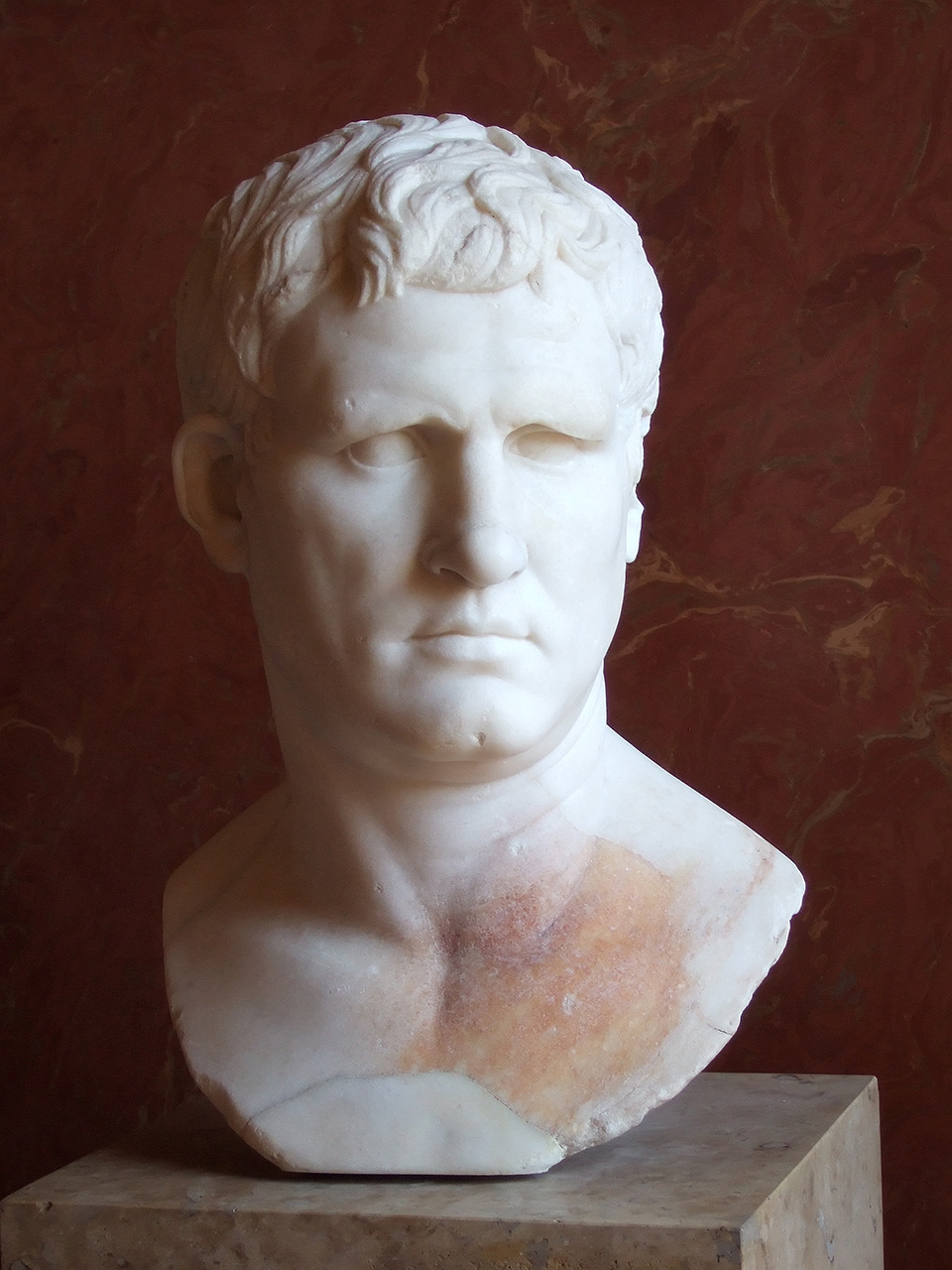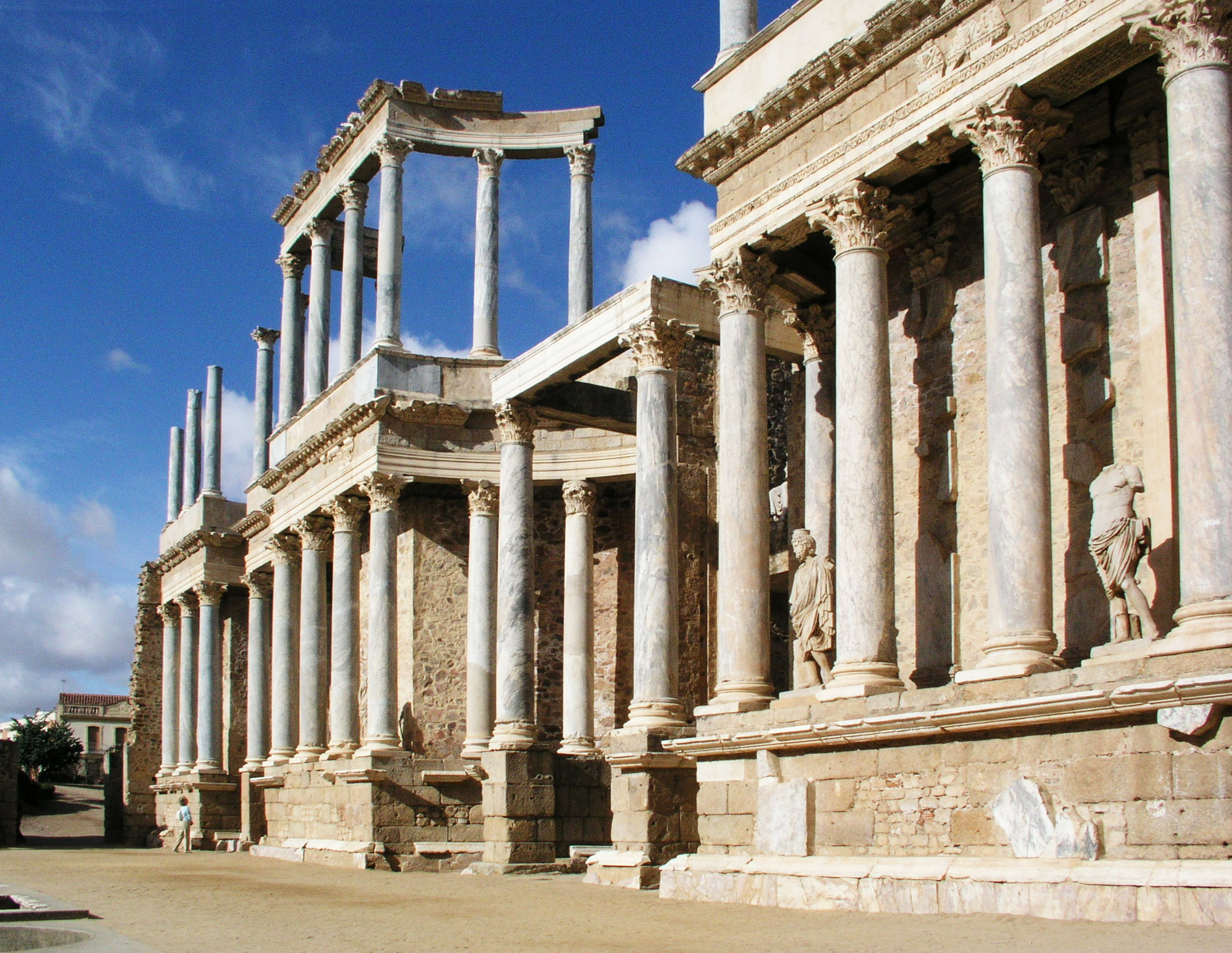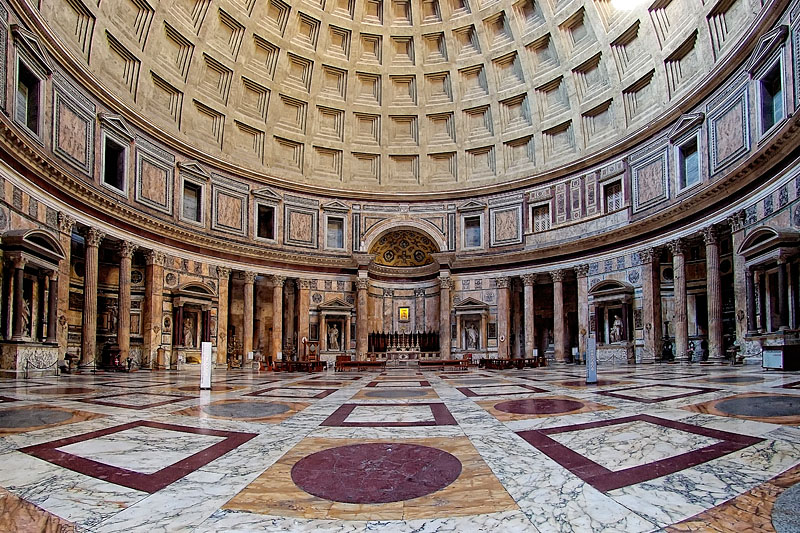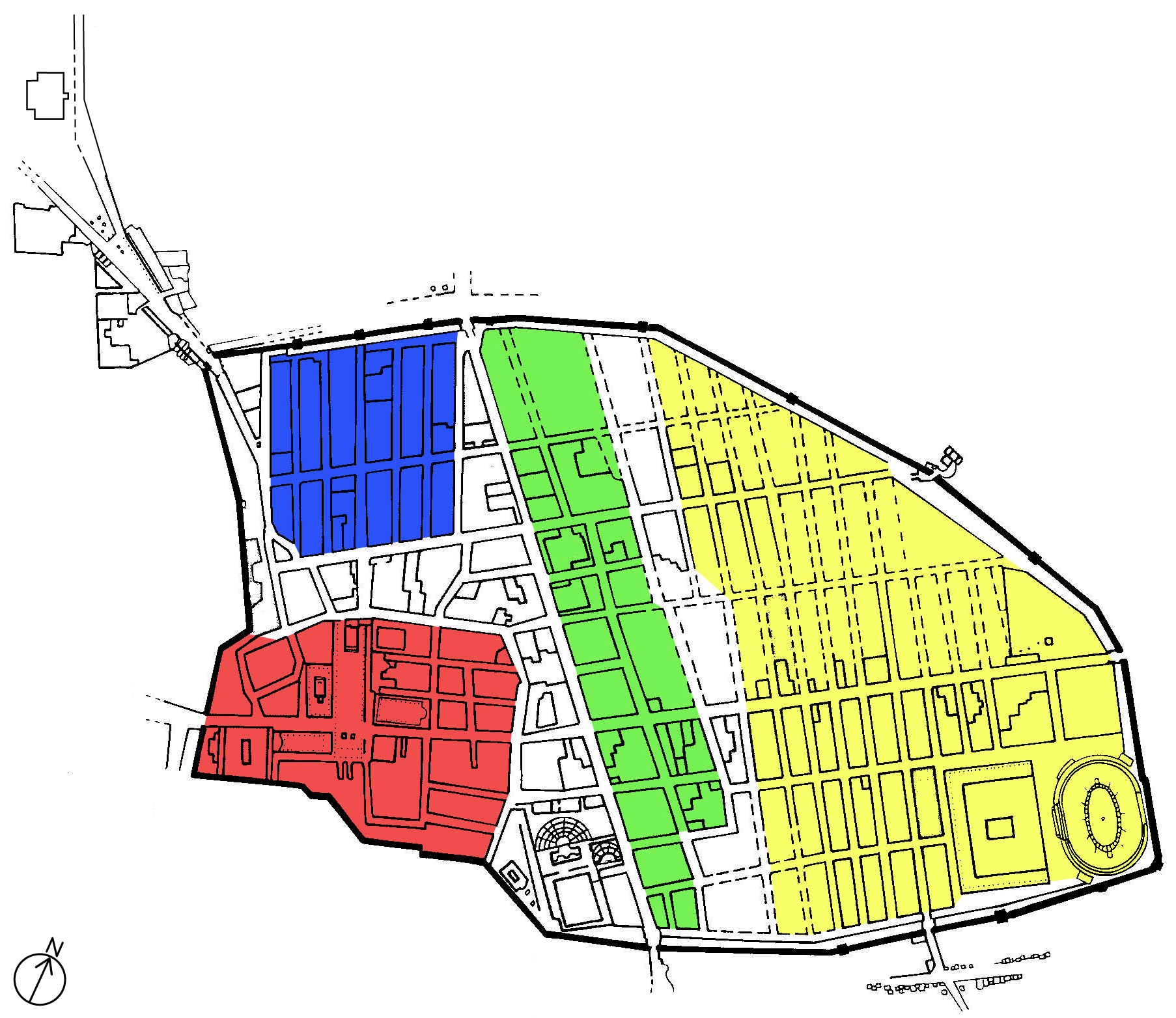|
Laconicum
The ''laconicum'' (i.e. Spartan, ''sc.'' ''balneum'', "bath") was the dry sweating room of the Roman ''thermae'', sometimes contiguous to the ''caldarium'' or hot room. The name was given to it (Laconia: Sparta) since it was the only form of warm bath that the Spartans admitted. The ''laconicum'' was usually a circular room with niches in the axes of the diagonals and was covered by a conical roof with a circular opening at the top, according to Vitruvius (v. 10), from which a brazen shield is suspended by chains, capable of being so lowered and raised as to regulate the temperature. It is similar to a '' sudatorium'', or steam bath, where water is added to produce steam. Sometimes, as in the old baths at Pompeii, the ''laconicum'' was provided in an apse at one end of the ''caldarium'', but as a rule it was a separate room raised to a higher temperature and had no bath in it. In addition to the hypocaust under the floor, the wall was lined with ceramic flue pipes. The largest '' ... [...More Info...] [...Related Items...] OR: [Wikipedia] [Google] [Baidu] |
Thermae
In ancient Rome, (from Greek , "hot") and (from Greek ) were facilities for bathing. usually refers to the large Roman Empire, imperial public bath, bath complexes, while were smaller-scale facilities, public or private, that existed in great numbers throughout Rome. Most Roman cities had at least one – if not many – such buildings, which were centers not only for bathing, but socializing and reading as well. Bathhouses were also provided for wealthy private Roman villa, villas, domus, town houses, and castra, forts. They were supplied with water from an adjacent river or stream, or within cities by aqueduct (watercourse), aqueduct. The water would be heated by fire then channelled into the caldarium (hot bathing room). The design of baths is discussed by Vitruvius in ''De architectura'(V.10) Terminology '','' '','' '','' and may all be translated as 'bath' or 'baths', though Latin sources distinguish among these terms. or , derived from the Greek language, G ... [...More Info...] [...Related Items...] OR: [Wikipedia] [Google] [Baidu] |
Caldarium
image:Caldarium.JPG, 230px, ''Caldarium'' from the Roman baths at Bath, Somerset, Bath, England. The floor has been removed to reveal the empty space where the hot air flowed through to heat the floor. A (also called a ''calidarium'', ''cella caldaria'' or ''cella coctilium'') was a room with a hot plunge bath, used in a Thermae, Roman bath complex. The boiler supplying hot water to a baths complex was also called . This was a very hot and steamy room heated by a hypocaust, an underfloor heating system using tunnels with hot air, heated by a furnace tended by slaves. It was also the hottest room in the regular sequence of bathing rooms; after the ''caldarium'', bathers would progress back through the ''tepidarium'' to the ''frigidarium''. A in both public and private baths followed a common plan which had three main parts. The common arrangement would include a warm-water bath -- usually called , but also referred to as or -- sunk into the floor, a semicircular alcove -- ... [...More Info...] [...Related Items...] OR: [Wikipedia] [Google] [Baidu] |
Ancient Roman Bathing
Bathing played a major part in ancient Roman culture and society. It was one of the most common daily activities and was practiced across a wide variety of social classes. Though many contemporary cultures see bathing as a private activity conducted in the home, bathing in Rome was a communal activity. While the extremely wealthy could afford bathing facilities in their homes, private baths were very uncommon, and most people bathed in the communal baths (''thermae''). In some ways, these resembled modern-day destination spas as there were facilities for a variety of activities from exercising to sunbathing to swimming and massage. Such was the importance of baths to Romans that a catalogue of buildings in Rome from 354 AD documented 952 baths of varying sizes in the city. Public baths became common throughout the empire as a symbol of "Romanitas" or a way to define themselves as Roman. They were some of the most common and most important public buildings in the empire as some ... [...More Info...] [...Related Items...] OR: [Wikipedia] [Google] [Baidu] |
Sudatorium
In architecture, a sudatorium is a vaulted sweating-room ('' sudor'', "sweat") or steam bath (Latin: ''sudationes'', steam) of the Roman baths or thermae. The Roman architectural writer Vitruvius (v. 2) refers to it as ''concamerata sudatio''. It is similar to a '' laconicum'', or dry heat bath, with the addition of water to produce steam. In order to obtain the great heat required, the whole wall was lined with vertical terracotta flue pipes of rectangular section, placed side by side, through which hot air and smoke from the suspensura passed to an exit in the roof. When Arabs and Turks overran the Eastern Roman Empire The Byzantine Empire, also known as the Eastern Roman Empire, was the continuation of the Roman Empire centred on Constantinople during late antiquity and the Middle Ages. Having survived the events that caused the fall of the Western Roman E ..., they adopted and developed this feature in their baths or hammams. References Ancient Roman baths Rooms [...More Info...] [...Related Items...] OR: [Wikipedia] [Google] [Baidu] |
Baths Of Agrippa
The Baths of Agrippa () was a structure of ancient Rome, Italy, built by Marcus Vipsanius Agrippa. It was the first of the great thermae constructed in the city, and also the first public bath. The remains were incorporated into more modern buildings including the massive 25 m diameter wall that was part of the hall. Old plans drawn by Peruzzi and Palladio record the remains from the period when much was still intact. History In the bath's first form, completed in 25 BC, it was a hot-air room also known as a "laconian sudatorium or gymnasium". With the completion of the Aqua Virgo in 19 BC, the baths were supplied with water and with the addition of a large lake and canal ('' Stagnum Agrippae''). [...More Info...] [...Related Items...] OR: [Wikipedia] [Google] [Baidu] |
Chedworth Roman Villa 2012 - North Bath House
Chedworth is a village and civil parish in Gloucestershire, southwest England, in the Cotswolds. It is known as the location of Chedworth Roman Villa, administered since 1924 by the National Trust. Chedworth Stream rises close to the village and flows east for about in a narrow valley before joining the River Coln at the point where it is crossed by the ancient Fosse Way. Roman villa The villa is a 1,700-year-old farmstead between Yanworth and Withington, about 3 miles (5.5 km) from Chedworth village by road, although it sits to the south of the River Coln and so is within Chedworth parish. It is connected with Chedworth village by two long-distance footpaths, the Macmillan Way and the Monarch's Way, both about 1 mile in walking distance. The villa was discovered by chance in 1864. It is the remains of one of the largest Romano-British villas in England, featuring several mosaics, two bathhouses, hypocausts (underfloor heating), a water-shrine and a latrine. The water shri ... [...More Info...] [...Related Items...] OR: [Wikipedia] [Google] [Baidu] |
Marcus Vipsanius Agrippa
Marcus Vipsanius Agrippa (; BC – 12 BC) was a Roman general, statesman and architect who was a close friend, son-in-law and lieutenant to the Roman emperor Augustus. Agrippa is well known for his important military victories, notably the Battle of Actium in 31 BC against the forces of Mark Antony and Cleopatra. He was also responsible for the construction of some of the most notable buildings of his era, including the original Pantheon. Born to a plebeian family , in an uncertain location in Roman Italy, he met the future emperor Augustus, then known as Octavian, at Apollonia, in Illyria. Following the assassination of Octavian's great-uncle Julius Caesar in 44 BC, Octavian returned to Italy. Around this time, Agrippa was elected tribune of the plebs. He served as a military commander, fighting alongside Octavian and Caesar's former general and right-hand man Mark Antony in the Battle of Philippi. In 40 BC, he was ''praetor urbanus'' and played a major role in the Peru ... [...More Info...] [...Related Items...] OR: [Wikipedia] [Google] [Baidu] |
Septimius Severus
Lucius Septimius Severus (; ; 11 April 145 – 4 February 211) was Roman emperor from 193 to 211. He was born in Leptis Magna (present-day Al-Khums, Libya) in the Roman province of Africa. As a young man he advanced through cursus honorum, the customary succession of offices under the reigns of Marcus Aurelius and Commodus. Severus was the final contender to seize power after the death of the emperor Pertinax in 193 during the Year of the Five Emperors. After deposing and killing the incumbent emperor Didius Julianus, Severus fought his rival claimants, the Roman generals Pescennius Niger and Clodius Albinus. Niger was defeated in 194 at the Battle of Issus (194), Battle of Issus in Cilicia (Roman province), Cilicia. Later that year Severus waged a short punitive campaign beyond the eastern frontier, annexing the Osroene, Kingdom of Osroene as a new province. Severus defeated Albinus three years later at the Battle of Lugdunum in Roman Gaul, Gaul. Following the consolidation of ... [...More Info...] [...Related Items...] OR: [Wikipedia] [Google] [Baidu] |
Cassius Dio
Lucius Cassius Dio (), also known as Dio Cassius ( ), was a Roman historian and senator of maternal Greek origin. He published 80 volumes of the history of ancient Rome, beginning with the arrival of Aeneas in Italy. The volumes documented the subsequent founding of Rome (753 BC), the formation of the Republic (509 BC), and the creation of the Empire (27 BC) up until 229 AD, during the reign of Severus Alexander. Written in Koine Greek over 22 years, Dio's work covers approximately 1,000 years of history. Many of his books have survived intact, alongside summaries edited by later authors such as Xiphilinus, a Byzantine monk of the 11th century, and Zonaras, a Byzantine chronicler of the 12th century. Biography Lucius Cassius Dio was the son of Cassius Apronianus, a Roman senator and member of the Cassia gens, who was born and raised at Nicaea in Bithynia. Byzantine tradition maintains that Dio's mother was the daughter or sister of the Greek orator and philosopher, ... [...More Info...] [...Related Items...] OR: [Wikipedia] [Google] [Baidu] |
Pantheon, Rome
The Pantheon (, ; ,Although the spelling ''Pantheon'' is standard in English, only ''Pantheum'' is found in classical Latin; see, for example, Pliny, ''Natural History'36.38 "Agrippas Pantheum decoravit Diogenes Atheniensis". See also ''Oxford Latin Dictionary'', s.v. "Pantheum"; ''Oxford English Dictionary'', s.v"Pantheon" "post-classical Latin ''pantheon'' a temple consecrated to all the gods (6th cent.; compare classical Latin ''pantheum'')". ) is an ancient 2nd century Roman temple and, since AD 609, a Catholic church called the Basilica of St. Mary and the Martyrs () in Rome, Italy. It is perhaps the most famous, and architecturally most influential, rotunda. The Pantheon was built on the site of an earlier temple, which had been commissioned by Marcus Vipsanius Agrippa during the reign of Augustus (27 BC – AD 14). After the original burnt down, the present building was ordered by the emperor Hadrian and probably dedicated AD 126. Its date of construction i ... [...More Info...] [...Related Items...] OR: [Wikipedia] [Google] [Baidu] |
Pompeii
Pompeii ( ; ) was a city in what is now the municipality of Pompei, near Naples, in the Campania region of Italy. Along with Herculaneum, Stabiae, and Villa Boscoreale, many surrounding villas, the city was buried under of volcanic ash and pumice in the eruption of Mount Vesuvius in 79 AD. Largely preserved under the ash, Pompeii offers a unique snapshot of Culture of ancient Rome, Roman life, frozen at the moment it was buried, as well as insight into ancient urban planning. It was a wealthy town of 10,000 to 20,000 residents at the time it was destroyed. It hosted many fine public buildings and luxurious private houses with lavish decorations, furnishings and artworks, which were the main attractions for early excavators; subsequent excavations have found hundreds of private homes and businesses reflecting various architectural styles and social classes, as well as numerous public buildings. Organic remains, including wooden objects and human bodies, were interred in the as ... [...More Info...] [...Related Items...] OR: [Wikipedia] [Google] [Baidu] |
Flue
A flue is a duct, pipe, or opening in a chimney for conveying exhaust gases from a fireplace, furnace, water heater, boiler, or generator to the outdoors. Historically the term flue meant the chimney itself. In the United States, they are also known as vents for boilers and as breeching for water heaters and modern furnaces. They usually operate by buoyancy, also known as the stack effect, or the combustion products may be "induced" via a blower. As combustion products contain carbon monoxide and other dangerous compounds, proper "draft", and admission of replacement air is imperative. Building codes, and other standards, regulate their materials, design, and installation. Heat retention Flues are adjustable and are designed to release noxious gases to the atmosphere. They often have the disadvantageous effect of releasing useful household heat to the atmosphere when not properly set—the very opposite of why the fire was lit in the first place. Fireplaces are one ... [...More Info...] [...Related Items...] OR: [Wikipedia] [Google] [Baidu] |







